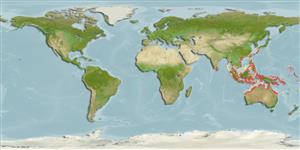Teleostei (teleosts) >
Ovalentaria/misc (Various families in series Ovalentaria) >
Pseudochromidae (Dottybacks) > Congrogadinae
Etymology: Congrogadus: Latin, conger = conger + Latin, gadus = a fish, perhaps cod (Ref. 45335).
More on author: Richardson.
Environment: milieu / climate zone / depth range / distribution range
Ecology
Marine; brackish; reef-associated; depth range 0 - 10 m (Ref. 90102). Tropical; 35°N - 25°S
Indo-West Pacific: Nicobar Islands, Andaman Sea and Japan to the tropical coasts of Australia.
Length at first maturity / Size / Weight / Age
Maturity: Lm ?, range 20 - ? cm
Max length : 45.0 cm TL male/unsexed; (Ref. 3132)
Dorsal
spines
(total): 0;
Dorsal
soft rays
(total): 68-74;
Anal
spines: 0;
Anal
soft rays: 57 - 66;
Vertebrae: 74 - 84. Coloration varied, capable of changing its color. Spots or blotches on body form reticulations and crossbands; paler ventrally. Gill membranes ventrally free from the isthmus. Posterior otic sensory canal pore present. Cephalic sensory canal pores not pigmented.
Inhabits coastal waters, often in brackish conditions (Ref. 48636). Found hidden amongst rocks or coral rubble (Ref. 48636). Reproductive activity appears to be cyclical and the species may not be a protogynous hermaphrodite (Ref. 2077). Also found in coral reefs among crevices (Ref 90102).
Life cycle and mating behavior
Maturity | Reproduction | Spawning | Eggs | Fecundity | Larvae
Winterbottom, R., 1985. Revision and vicariance biogeography of the subfamily Congrogadidae (Pisces: Perciformes: Pseudochromidae). Indo-Pac. Fish. (9):34 p. (Ref. 531)
IUCN Red List Status (Ref. 130435)
Threat to humans
Harmless
Human uses
Aquarium: commercial
More information
ReferencesAquacultureAquaculture profileStrainsGeneticsElectrophoresesHeritabilityDiseasesProcessingNutrientsMass conversion
Tools
Special reports
Download XML
Internet sources
Estimates based on models
Preferred temperature (Ref.
123201): 25.2 - 29.3, mean 28.6 °C (based on 2277 cells).
Phylogenetic diversity index (Ref.
82804): PD
50 = 0.5156 [Uniqueness, from 0.5 = low to 2.0 = high].
Bayesian length-weight: a=0.00389 (0.00180 - 0.00842), b=3.12 (2.94 - 3.30), in cm total length, based on all LWR estimates for this body shape (Ref.
93245).
Trophic level (Ref.
69278): 4.0 ±0.67 se; based on food items.
Resilience (Ref.
120179): Medium, minimum population doubling time 1.4 - 4.4 years (Preliminary K or Fecundity.).
Fishing Vulnerability (Ref.
59153): Low to moderate vulnerability (35 of 100).
Nutrients (Ref.
124155): Calcium = 48.3 [25.0, 78.7] mg/100g; Iron = 0.465 [0.275, 0.778] mg/100g; Protein = 19.1 [18.0, 20.3] %; Omega3 = 0.0831 [, ] g/100g; Selenium = 24 [12, 45] μg/100g; VitaminA = 89 [31, 264] μg/100g; Zinc = 1.35 [0.92, 1.88] mg/100g (wet weight);
